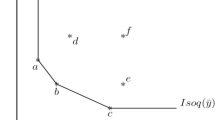Abstract
The minimum cost for reducing the farmers' use of pesticides is calculated. The measures include are; (i) a decrease in use of inputs, (ii) an improvement of the insurance system, and (iii) application of an ecotechnology where 5–10 meters along the borders of the fields are left untreated with pesticides. The cost of reducing the use of pesticides is measured by means of pesticide demand functions and the cost for improving an insurance system is measured as the risk premium. The empirical results indicate that the minimum cost for reducing the use of pesticides by 50% in Sweden corresponds to about 6 per cent of farmers' incomes from crop production. A simple comparison of policy instruments shows that the cost of a quota system is about 40 per cent higher than the costs of the charge and permit market systems. The farmers' decreases in incomes under a charge system are twice as high as under the other two policy instruments. The results are, however, sensitive to the levels of the pesticide price elasticities.
Similar content being viewed by others
References
Andersson, A., H. Pålsheden and T. Bergh (1991),Pesticide Residues in Fruits and Vegetables — 1990, National Food Administration, Rapport 5, Uppsala.
Andréasson-Gren, I-M. (1992), ‘Profits from Violating Controls on the Use of a Polluting Input’,Environmental and Resource Economics 5, 459–468.
Antle, J. M. (1988),Pesticide Policy, Production Risk, and Producer Welfare, An Econometric Approach to Applied Welfare Economics, Resources for the Future, Washington, D.C.
Bohm, P. and C. S. Russel (1985), ‘Comparative Analysis of Alternative Policy Instruments’, in A. V. Kneeseand and J. L. Sweeney, eds,Handbook of Natural Resource and Energy Economics 1, Elsevier Science Publisher B.V.
Brooke, A., D. Kendrick and A. Meeraus (1988),GAMS, The International Bank for Reconstruction and Development/The World Bank, U.S.A.
Carson, R. (1962),Silent Spring, Penguin Books, London.
Dubgaard, A. (1987),Anvendelse af Afgifter til Regulering af Pesticidforbruget, Statens Jordbrugsökonomiske Institut. Rapport 35.
Fogelfors, H., B. Johnsson, O. Pettersson and F. Petrini (1991),Miljövänlig Bekämpning i Jordbruket — En Diskussion av Möjligheter och Konsekvenser, Research paper. Department of Economics, The Swedish University of Agricultural Sciences, Uppsala.
Gren, I-M. (1992),Regulating Farmers' Use of Pesticides in Sweden, Beijer Discussion Paper Series No. 12. The Beijer International Institute of Ecological Economics, The Royal Swedish Academy of Sciences, Stockholm.
Hansen, P. E. and S. E. Jörgensen (1991),Introduction to Environmental Management, Elsevier.
Johnsson, B. (1991),Kostnader för Begränsad Användning av Kemiska Bekämpningsmedel, Research paper. Department of Economics, Swedish University of Agricultural Sciences, Uppsala.
Lantbruksstyrelsen (1991),Problemområden i Yttre Miljön vid Kemisk Bekämpning — Förslag till Åtgärder, Rapport 1991: 2.
Lau, L. J. (1978), ‘Applications of Profit Functions’, in Fuss, M. MacFadden, eds.,Production Economics: A Dual Approach to Theory and Applications, North-Holland, Amsterdam. The Netherlands.
Lichtenberg, E. D. D. Parker and D. Zilberman (1988), ‘Marginal Analysis of Welfare Costs of Environmental Policies: The Case of Pesticide Regulation’,American Journal of Agricultural Economics 70(4), 866–874.
Mitsch, W. J. and S. E. Jörgensen (1989),Ecological Engineering. An Introduction to Ecotechnology, John Wiley & Sons.
Moffitt, L. J. (1986), ‘Risk-Efficient Thresholds for Pest Control Decisions’,Journal of Agricultural Economics.
Myers, R. J. (1986),Econometric Test for Risk Averse Behaviour in Agriculture, Staff Paper No. 86–98, Department of Agricultural Economics, Michigan State University, East Lansin, Michigan.
Opschoor, H. and D. Pearce, eds. (1991),Persistent Pollutants: Economics and Policy, Kluwer Academic Publishers, Dordrecht, The Netherlands.
Pope, R. D. and R. A. Kramer (1979), ‘Production Uncertainty and the Factor Demands for the Competitive Firm’,Southern Economic Journal 60, 425–435.
Russel, C. S. and J. F. Shogren, eds. (1993),Theory, Modelling and Experience in the Management of Nonpoint-Source Pollution, Kluwer Academic Publishers, Boston, U.S.A.
Tietenberg, T. H. (1984),Marketable Emission Permits in Principle and Practice, Presented at the Economics of Energy Environmental Policies conference, Stockholm School of Economics.
Tietenberg, T. H. (1992),Innovation in Environmental Policy. Economic and Legal Aspects of Recent Developments in Environmental Enforcement and Liability, Edward Elgar Publishing, England.
Torstensson, L., Department of Microbiology, The Swedish University of Agricultural Sciences, Uppsala, Sweden.
Wilson, P. N. and V. R. Eidman (1983), ‘An Empirical Test of the Interval Approach for Estimating Risk Preferences’,Western Journal of Agricultural Economics 8, 170–182.
Author information
Authors and Affiliations
Rights and permissions
About this article
Cite this article
Gren, IM. Cost efficient pesticide reductions: A study of Sweden. Environ Resource Econ 4, 279–293 (1994). https://doi.org/10.1007/BF00692329
Issue Date:
DOI: https://doi.org/10.1007/BF00692329




